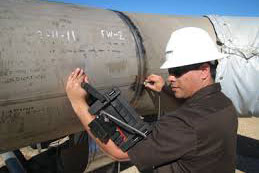The Ultimate List for Welding Inspection Gilbert Arizona: Ensuring Safety and Accuracy
The Ultimate List for Welding Inspection Gilbert Arizona: Ensuring Safety and Accuracy
Blog Article
A Comprehensive Guide to Welding Assessment: Recognizing Requirements, Techniques, and Best Practices for Quality Control

Welding evaluation plays a critical function in making sure the architectural stability and security of bonded elements, requiring a thorough understanding of industry standards such as those established by AWS and ASME. Various evaluation techniques, including visual and ultrasonic testing, are employed to discover prospective issues that can compromise high quality. Implementing ideal techniques can substantially boost functional dependability and foster trust amongst clients. Welding Inspection Gilbert Arizona. As we explore these crucial aspects, it comes to be noticeable that the ramifications of welding examination expand far beyond conformity, inviting a closer examination of just how these processes form industry criteria and methods.
Significance of Welding Evaluation
Welding inspection plays an essential duty in making certain the stability and safety and security of welded frameworks. It is a necessary process that confirms that welds adhere to predefined requirements, which is crucial in different industries, including building, automotive, and aerospace. By performing complete evaluations, possible issues such as cracks, incomplete combination, and porosity can be recognized early, preventing devastating failures that might bring about accidents or expensive fixings.
The relevance of welding inspection extends beyond mere compliance with guidelines; it additionally cultivates trust fund with stakeholders. Customers and regulatory bodies expect assurance that the structures they depend on are constructed to withstand functional stresses. Additionally, efficient welding assessment methods add to long-term toughness and efficiency of the frameworks, inevitably bring about decreased maintenance expenses.
In addition, welding examination advertises a culture of quality within companies, urging adherence to finest practices and continuous renovation. By integrating inspection procedures into the welding workflow, firms can improve their credibility and develop themselves as leaders in quality control. Finally, the significance of welding examination depends on its ability to guard lives, make sure structural reliability, and promote market standards, making it an essential facet of welding procedures.
Key Sector Specifications
Guaranteeing compliance with crucial market requirements is vital for keeping the top quality and security of welded frameworks. Different organizations develop these requirements to promote ideal methods in welding and inspection. Amongst the most acknowledged are the American Welding Culture (AWS) and the American Society of Mechanical Designers (ASME), which supply detailed guidelines and specifications for welding processes and evaluation criteria.
AWS standards, such as AWS D1.1 for architectural welding, summary demands for materials, style, and testing to make certain the stability of welds. Likewise, ASME codes, consisting of ASME Area IX, control the certification of welders and welding treatments, ensuring constant quality in commercial applications. Globally, the ISO 3834 basic highlights high quality needs for blend welding, providing a framework for organizations to demonstrate compliance with worldwide finest methods.
Conformity with these criteria not just boosts the integrity of bonded frameworks but also minimizes risks related to structural failures. Adherence to sector standards is often a prerequisite for regulative approvals and can considerably influence task specifications. Eventually, understanding and applying these key requirements are important for effective welding assessment and top quality assurance.
Evaluation Techniques Introduction
Reliable welding inspection depends on a selection of methods designed to assess the top quality and honesty of welds. These strategies can be extensively classified right into damaging and non-destructive screening (NDT) methods. Non-destructive screening techniques, which are extensively liked in the industry, permit for the assessment of welds without compromising the honesty of the material.
Amongst the most commonly utilized NDT techniques are aesthetic evaluation, ultrasonic screening, radiographic testing, and magnetic fragment testing. Aesthetic evaluation is frequently the primary step in the analysis process, making it possible for examiners to identify surface area imperfections and examine go weld bead accounts. Ultrasonic testing uses high-frequency sound waves to identify interior defects and measure the density of welds. Radiographic screening involves making use of X-ray or gamma-ray imaging to reveal inner flaws, while magnetic particle testing is efficient for discovering surface area and near-surface interruptions in ferromagnetic materials.
Each technique has its own advantages and restrictions, making it essential for examiners to select one of the most suitable approach based upon the particular needs of the project, the materials involved, and the urgency of the welds being examined. This mindful selection promotes and makes sure thorough assessments security and high quality criteria in welding operations.

Typical Issues and Their Implications
A complete understanding of typical flaws in welds is critical for preserving architectural stability and security in welded buildings. Welding defects can dramatically endanger the mechanical properties of the joint, leading to failings that can threaten both workers and tools.
Typical problems include porosity, which shows up as little gas pockets caught in the weld metal, damaging the general structure. Breaking is another widespread problem, frequently resulting from quick cooling or improper joint layout, causing tension concentrations that can cause disastrous failures. Insufficient fusion takes place when the weld steel stops working to correctly bond with the base product, developing weak points that may lead to splitting up under lots.
Various other noteworthy defects include undercutting, where the weld grain wears down the base steel, and slag inclusions, which can impede the weld's toughness. Each of these defects has certain effects; for example, porosity can minimize ductility, while cracking directly influences tensile strength. Determining and recognizing these defects during examination is vital for applying corrective procedures and ensuring compliance with market criteria, ultimately guarding the architectural stability of bonded assemblies.
Best Practices for Quality Control
Carrying out best methods for top quality guarantee in welding processes is necessary for achieving ideal outcomes and minimizing defects. One vital technique is the facility of clear welding procedures that comply with market standards and specs. These treatments should consist Discover More of thorough instructions relating to product choice, joint preparation, and welding methods to guarantee uniformity and quality.
Normal training and accreditation of welding employees are additionally essential. Proficient welders that comprehend the relevance of quality control are more probable to generate audio welds. Additionally, applying a robust evaluation program, consisting of both aesthetic and non-destructive screening (NDT), can aid recognize defects early in the process, enabling timely restorative activities.
Documentation plays a key role in high quality guarantee. Preserving accurate records of welding examinations, repair services, and criteria guarantees traceability and responsibility. In addition, using innovative modern technologies such as automated welding find out this here makers can enhance precision and reduce the potential for human mistake - Welding Inspection Gilbert Arizona.
Finally, fostering a culture of top quality within the organization urges staff members to prioritize top quality in their work. By sticking to these best methods, companies can enhance the honesty of their welding processes, inevitably bring about improved product top quality and reduced costs connected with rework and repair work.

Conclusion
To conclude, welding inspection plays a crucial role in making certain the integrity and safety of welded frameworks. Adherence to essential market standards, such as those developed by AWS and ASME, is essential for reliable top quality assurance. Utilizing different evaluation techniques enables the recognition of typical issues, consequently minimizing prospective dangers. By carrying out best methods, organizations can improve reliability, lessen upkeep costs, and grow trust among customers, eventually adding to effective welding procedures.
Furthermore, welding inspection advertises a culture of high quality within organizations, motivating adherence to best methods and continual enhancement. In final thought, the significance of welding assessment lies in its ability to secure lives, guarantee structural dependability, and promote market criteria, making it an indispensable facet of welding operations.
Amongst the most identified are the American Welding Culture (AWS) and the American Society of Mechanical Engineers (ASME), which give thorough guidelines and specifications for welding procedures and assessment requirements.
Ultimately, understanding and implementing these essential criteria are vital for reliable welding inspection and quality guarantee.
Efficient welding assessment relies on a range of strategies designed to examine the quality and integrity of welds. - Welding Inspection Gilbert Arizona
Report this page